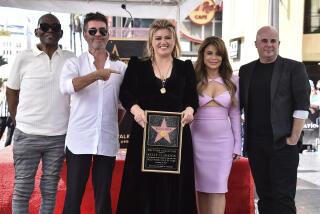‘Outsider’ Feeling Right at Home in New Role as Governor-General
- Share via
OTTAWA — Adrienne Clarkson may seem an unlikely choice for Canada’s governor-general, the representative of Queen Elizabeth II.
An immigrant from Hong Kong who arrived here in 1942 without papers, Clarkson has a background that’s not British, not French, not native Canadian. At 60, she is a well-known TV journalist and author who has spent a lifetime crossing boundaries, not a member of the political establishment that created them.
But that, she argues, is exactly what makes her perfect for the job.
“My education, my formation, all the important influences outside my emotional childhood world were through Canadian public institutions,” she said at her new royal residence, a 79-acre estate called Rideau Hall. “So there is no accident about the fact that I now really kind of represent it.”
More than that, she is drawing new attention--and support--to the British monarchy, an institution that some here have suggested should be allowed to pass away with the current queen.
Clarkson--or “her excellency,” as she is now known--became governor-general in October during a ceremony that included beaver-hatted Mounties, a plush scarlet throne and a 21-gun salute. A black limousine took her on a symbolic ride past the house where her fresh-off-the-boat family first lived and through Ottawa to the grand gates of Rideau Hall.
But earlier in the day, her investiture speech showed that she was going to add a little poetry and pizazz to the pomp and circumstance. In an address spiked with richly varied references, from an Ojibway chieftain’s invitation to lyrics from songwriter Leonard Cohen, she set out to shake up the staid Canadian establishment while reinvigorating the fading monarchy.
“Canada’s institutions have never been static. They are organic--evolving and growing in ways that surprise and even startle us,” she said. She recounted arriving as a refugee in a city that was “small and white.” Citing writer Mavis Gallant, she said Ottawa was marked then “with the mistrust of pity, the contempt for weakness, the fear of the open heart.”
The message was clear: Her own journey from immigrant to Canadian symbol mirrored the country’s postwar evolution to a more inclusive present.
“We are constructing something different here,” she said, slipping in the words of Canadian poet Jean-Guy Pilon to describe the defiance, self-reliance and originality that define Canada old and new: “Tormented roots that defy the flames; spitting in the face of stars. Here the builders breathe, and grow.”
Appointment Rankles Some Traditionalists
The speech signaled a new activist approach to her post, which is largely ceremonial. In the absence of the queen, Clarkson fulfills royal duties--everything from awarding the nation’s hockey champions the Stanley Cup to signing all legislation and warding off national political crises.
“It does not mean that you call the queen on a weekly basis,” she said. “The role of the governor-general is to ensure political stability.”
Traditionalists have bridled at the post’s being held by a woman from neither Canada nor its founding countries, Britain and France. Republicans say it should be filled by election. Journalists have dredged Clarkson’s past to unearth an estranged first husband and a pair of daughters she doesn’t mention in her Who’s Who listing.
She lived with her companion, philosopher and writer John Ralston Saul, for nearly two decades before being nudged into marriage in July by hints of the impending appointment. (“We have been married a short enough time to be enjoying it, and a long enough time to be respectable,” she said.)
Gossips spotlight her feuds with her neighbors and point out echoes from her laureate husband’s books in her speeches. They scrutinize her spending habits, the new kitchen she installed in Rideau Hall and her dictate that only organic food will be served there.
As a former journalist, she tries to be understanding. “But potshotting at my personal life is not journalism,” she sniffed, “and it’s not relevant.”
And despite the carping, Clarkson clearly has brought new support to the monarchy. A Gallup Poll conducted shortly after her appointment was announced showed a surprising rise in the queen’s backing--by 8 percentage points compared with the previous year.
“She captures people’s imaginations in a way that hasn’t been done before,” said John Aimers, the dominion chairman of the Monarchist League of Canada. “Having the representative of the queen being as articulate and dynamic as she is, it not only helps the crown but also causes Canadians to reexamine what it means to be Canadian and to be distinct.”
More About Building Than Dreaming
As an outsider who has absorbed the essence of this nation, Clarkson has thought more than most about what it is to be Canadian. The Poy family arrived during wartime with one suitcase apiece, fleeing the Japanese occupation of Hong Kong. It was some time before Canada allowed Chinese to become citizens, and she recalls their struggle to fit in and yet retain their heritage.
At age 5, nuns turned her away from a Roman Catholic school. Clarkson credits her parents and public school teachers “who treated me only as bright--and not bright yellow” for shaping her into a Canadian.
Her parents expected Adrienne and her brother to succeed regardless of their circumstances. Even now, sitting in the opulent study of her sprawling stone residence, Clarkson is stirred by a memory of seeing “Gone With the Wind” with her mother. During the scene in which Scarlett O’Hara rips down the mansion’s curtains to make a presentable dress, she recalled, her mother leaned over to her and said, “You see, you can always do something with nothing!”
That, she said, is not only an immigrant mentality but a notion that captures the heart of Canadian identity.
“This is a terrific country,” she said. “It’s very different from the American concept of reaching for a dream. It’s not about that. It’s about constructing things.”
Clarkson built a life for herself, breaking into public television in its early stages, working as a producer, cultural program host and investigative reporter for 35 years until her face became recognizable in nearly every home.
She ran the country’s largest publishing company, headed a museum and for five years served as a diplomat in Paris. And she was perhaps the least surprised to hear that her name was on a short list for governor-general.
“I never see things as just happening as a fluke of luck,” she said.
Now, in Rideau Hall, she can claim a new tiger-studded family crest along with the governor-general’s standard of the royal lion, combining her family’s past with her present role. The crest mixes Chinese images--she was born in the Year of the Tiger, and a phoenix represents her family rising from hard times--with the Canadian symbols of a maple leaf and a loon.
But after 35 years in which Clarkson worked her way to the top, the crest is more a flourish than a declaration of identity.
“People understand who I am and what I stand for,” she said. “They feel like they know a bit about me already.”
More to Read
Sign up for Essential California
The most important California stories and recommendations in your inbox every morning.
You may occasionally receive promotional content from the Los Angeles Times.










